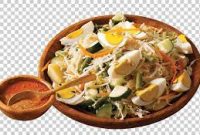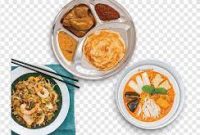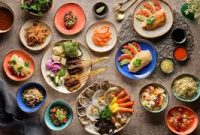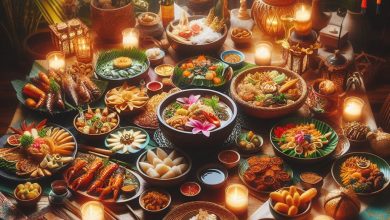What is historical food from Indonesia? How does Indonesian cuisine reflect Indonesia’s trading history?
historical food from Indonesia
historical food from Indonesia:
With a wide variety of cuisines influenced by its many regions and cultures, Indonesia has a rich culinary legacy. Here are a few traditional and historical Indonesian dishes:
Nasi Goreng: Known as the national cuisine, nasi goreng is a tasty fried rice meal that is typically topped with fried eggs, prawns, and chicken. It is frequently prepared with kecap manis (sweet soy sauce), shallots, garlic, tamarind, and chilli.
Satay: Meat on a skewer or grill is called satay, and it’s typically paired with a flavorful peanut sauce. It’s a well-liked street dish that might include lamb, beef, or chicken among other meats.
Rendang: Renderang is a thick and savory stew made with coconut and meat that originates in West Sumatra. The meat is tenderized and the sauce becomes thickened by slow cooking with coconut milk and a blend of spices.
Gado-Gado: a classic salad of boiled eggs, tofu, or tempeh, and veggies that is dressed with peanut sauce. It’s a wholesome and revitalizing dish.
Soto: Traditional Indonesian soups exist in several regional varieties, such as soto. Usually, it consists of broth, meat (mutton, beef, or chicken), and a combination of spices and vegetables.
Nasi Padang: Nasi Padang, which has its origins in Padang, West Sumatra, is a feast of several delicacies served over steamed rice. Curries, sambal, rendang, and other foods are examples of dishes.
Bakso: Meatballs known as “bakso” are often created by combining tapioca flour with beef flour. They are frequently served with noodles, tofu, and other ingredients in a bowl of soup.
Martabak: A martabak is a thick flatbread or pancake that is packed with a blend of spices, minced meat, and egg. Both savory and sweet varieties are available.
Rujak: Rujak is a classic fruit salad dressed with a spicy and sweet peanut sauce. It blends a variety of tropical fruits, including papaya, mango, and pineapple.
Nasi Uduk: Nasi Uduk is a Jakartan cuisine that consists of rice cooked in coconut milk and served with a variety of side dishes, including tempeh, fried chicken, and eggs.
With a variety of spices, herbs, and regional ingredients, these dishes showcase Indonesia’s many culinary traditions and contribute to its distinctive and tasty cuisine.


How does Indonesian cuisine reflect Indonesia’s trading history?
The wide variety of products, spices, and cooking methods that have been shaped by centuries of commerce with different civilizations are what make Indonesian cuisine a reflection of the nation’s trading past. Due to their expensive spices, the Spice Islands—which include parts of modern-day Indonesia—attracted traders from all over the world in the past. Here’s how this history of trade is reflected in Indonesian cuisine:
Use of Spices: The Spice Islands of Indonesia used to be the world’s main supplier of spices including mace, nutmeg, and cloves. These spices were quite popular and had a big impact on the development of international trade routes. As a result, the extensive use of spices in Indonesian cooking results in meals that are rich and aromatic.
Influence of Indian Traders: With the introduction of items like curries, tandoori-style cooking, and specific spices, Indian traders added to the richness of Indonesian cuisine. This influence is evident in dishes like rendang and recipes based on curries.
Chinese Culinary Influence: Indonesia and Chinese traders have a long history of dealing together. Indonesian food is influenced by Chinese cooking methods, ingredients including noodles and soy sauce, and the idea of stir-frying. Examples of this impact include numerous stir-fried foods prepared in the Chinese manner and bakmi, or noodles.
Arab and Middle Eastern Influence: Indonesia benefited from the introduction of rice, dates, and a variety of nuts by trade relations with the Arab world. Foods such as nasi uduk and several kinds of snacks are examples of this impact.
European Colonial Influence: Under the Dutch, Portuguese, and Spanish colonizers, Indonesia emerged as a major hub for the production of spices. The colonial powers introduced elements like potatoes, tomatoes, and chili peppers, which had a long-lasting effect on Indonesian cuisine.
Introduction of New Ingredients: Indonesia was introduced to new components through trade, such as fruits, vegetables, and sources of protein. These components were combined with regional food to create some very special meals.
Culinary Fusion: Indonesian food is a synthesis of many different cooking cultures. For instance, it’s believed that Middle Eastern and Indian culinary traditions impacted the usage of coconut milk in Indonesian cuisine.
Trade Routes and Coastal Cuisine: Maritime trade routes have an impact on Indonesia’s coastal districts. The abundance of seafood, coconut, and other spices in coastal cuisine is indicative of the historical significance of marine commerce.


All things considered, Indonesian food is a tapestry made from the strands of international commerce, representing a history of cultural interchange and adding to the nation’s gastronomic diversity.




